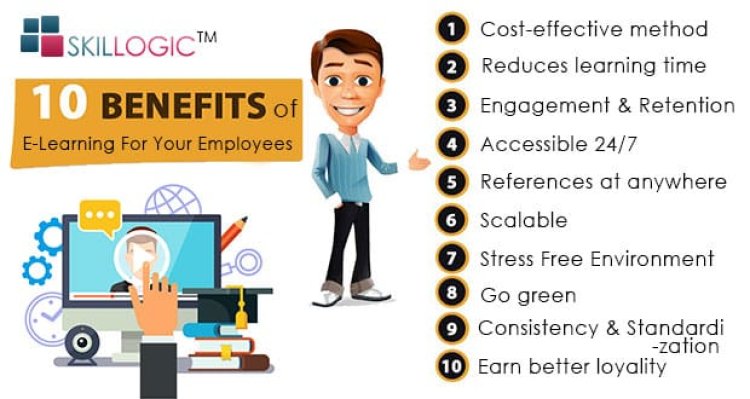
The landscape of education is evolving rapidly, driven by technological advancements and the growing prevalence of digital devices. E-learning, or electronic learning, has emerged as a transformative force, reshaping how education is delivered and experienced. By leveraging the internet and digital tools, e-learning offers new opportunities for learners and educators alike. This article delves into the core aspects of e-learning, its advantages, challenges E-learning, and its future prospects.
What is E-Learning?
E-learning refers to the use of digital technologies to facilitate and enhance the learning process. It encompasses a broad spectrum of methods, including online courses, virtual classrooms, webinars, and interactive multimedia content. Unlike traditional education, which relies on face-to-face interactions and physical materials, e-learning takes place in a virtual environment, making education accessible from virtually anywhere.
Benefits of E-Learning
- Accessibility and Reach: E-learning breaks down barriers related to location, enabling students from different parts of the world to access high-quality education without the need to relocate. This global reach is particularly advantageous for learners in remote or underserved areas, providing them with educational opportunities that might otherwise be unavailable.
- Flexibility and Convenience: One of the primary advantages of e-learning is its flexibility. Learners can access course materials and complete assignments at their own pace and on their own schedule. This flexibility is beneficial for individuals who need to balance their education with work, family, or other commitments, allowing them to tailor their learning experience to fit their lifestyle.
- Cost-Effectiveness: E-learning often proves to be more cost-effective than traditional education. The reduction in the need for physical infrastructure, such as classrooms and printed textbooks, lowers expenses for both educational institutions and students. Many e-learning resources are also available at lower costs or for free, making education more affordable and accessible.
- Personalized Learning: E-learning platforms frequently use adaptive learning technologies to provide a personalized educational experience. These systems analyze students’ progress and performance, tailoring content and assessments to address individual learning needs and preferences. This personalization enhances the effectiveness of the learning process and helps students achieve better outcomes.
- Interactive and Engaging Content: E-learning platforms can incorporate various multimedia elements, such as videos, animations, and interactive simulations, to make learning more engaging and effective. These tools can help clarify complex concepts and maintain learner interest through dynamic and interactive content.
Challenges of E-Learning
- Digital Divide: Despite its many advantages, e-learning relies on access to reliable internet and modern digital devices. The digital divide remains a significant challenge, particularly in low-income or rural areas where access to technology is limited. Addressing this gap is essential to ensuring that e-learning opportunities are available to everyone.
- Maintaining Engagement: Keeping learners engaged in a virtual environment can be challenging. Without the structure of a physical classroom and face-to-face interactions, some students may struggle with motivation and discipline. Effective e-learning requires strategies to foster engagement, such as interactive activities, regular feedback, and opportunities for virtual collaboration.
- Quality Assurance: The rapid growth of e-learning platforms has raised concerns about the quality and credibility of educational content. With a wide range of options available, learners need to carefully evaluate the quality and accreditation of courses and institutions to ensure they are receiving a valuable and legitimate education.
- Privacy and Security: E-learning platforms collect and store personal data, raising concerns about privacy and data security. Institutions must implement robust security measures to protect student information from breaches and unauthorized access, and comply with data protection regulations to maintain trust.
The Future of E-Learning
The future of e-learning is bright, with several emerging trends expected to shape its development:
- Artificial Intelligence (AI): AI technologies are set to revolutionize e-learning by offering personalized recommendations, automating administrative tasks, and providing real-time support. AI can analyze learner data to customize educational experiences and identify areas for improvement.
- Virtual Reality (VR) and Augmented Reality (AR): VR and AR technologies promise to create immersive learning environments, allowing students to interact with educational content in innovative ways. These technologies can offer hands-on experiences and simulations that enhance understanding and engagement.
- Blended Learning: The integration of e-learning with traditional classroom instruction, known as blended learning, offers a balanced approach that combines the strengths of both methods. This hybrid model provides flexibility while maintaining the benefits of in-person interaction.
Conclusion
E-learning represents a significant advancement in the field of education, offering increased accessibility, flexibility, and personalization. While challenges such as the digital divide and maintaining engagement need to be addressed, the benefits of e-learning are substantial. As technology continues to evolve, e-learning will play an increasingly central role in shaping the future of education, making learning more accessible, engaging, and effective for students worldwide. Embracing e-learning can lead to a more inclusive and dynamic educational environment, preparing learners for success in an ever-changing world.